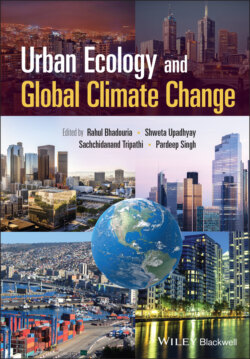Читать книгу Urban Ecology and Global Climate Change - Группа авторов - Страница 45
2.4.2 Mutualistic Relationship Between Urbanisation and Ecosystem
ОглавлениеIndustrialisation has been one of the most prominent causes of population changes in recent years, which is propelled by a multitude of societal, financial, and ecological mechanisms. Through the development of towns, communities, and infrastructure upgrades, urbanisation altered natural and previous rural habitats (Miller and Hutchins 2017). Smart employee population levels, expanded rough areas (e.g. roads and buildings), enhanced toxicity (e.g. air quality, light, soil), and high temperature are all characteristics of the novel, human urban setting. The urban sprawl resonance is a form in which cities are hotter than non‐urban areas due to the increased impermeable surfaces (e.g. gravel and mortar) and significantly lower tree cover. The trend and intensity of the interaction between urbanisation and ecological consequences can differ and evolve with present, based on the geographic, societal, and financial factors as well as progress trajectories, according to emerging evidence (Bai et al. 2017). Poor air quality is a dynamic combination of airborne pollutants emitted by a wide range of sources, including factories, residential gasification heating systems, automobiles, and industrialisation. Domestic air emissions and urban chemical fumes are the third and ninth leading causes of death and disease, respectively. The latter two are contributing for 6.6 million deaths and 7.6% of global, with pollutants accounting for 3.5% of global disease burden (Münzel et al. 2017a).
CVD is also known to be the leading cause of mortality (Dey et al. 2020). Air contamination containing fine particulate matter with a diameter of less than 2.5 μm (PM2.5) is the world's leading cause of death rates. Rigorous disposal of pollutants from urban centres, combined with an increase in impermeable surfaces as a result of urbanisation, will lead to a steady decline in the health of urban aquatic habitats, defined as the urban stream syndrome (Bai et al. 2017). Pollution from faecal matter and microbial pathogens, as well as antimicrobial agents, is common in urban environments, particularly urban aquatic environments. Toxins from marine ecosystems can be exported to lands through irrigation of reclaimed water and urban‐influenced river/stream water, posing a health risk (Miles et al. 2019). Changes in the global land use adversely affect the ecology and the atmosphere shape local and global climate by leading to thermal zone effect and disrupted biodiversity and propel multinational agricultural and forestry trading. Metropolitan composition can minimise power usage and fossil fuel used by transportation, but it also enhances the heat island effect and restricts groundwater infiltration. Abiotic stresses such as destruction and elimination of natural events, which inhibit ecosystem regeneration during advanced development stages, may be worsened by urban development (Johnson et al. 2019). While increased population and economic activities are often highlighted, studies indicate that the associated growth in environmental consequences, as manifested in property transition, generation of waste, air and water pollution, among other things, is much larger and faster. More analysis is required on such an intensifying and accelerating trend in urbanisation‐environmental linkages (Li et al. 2019).
